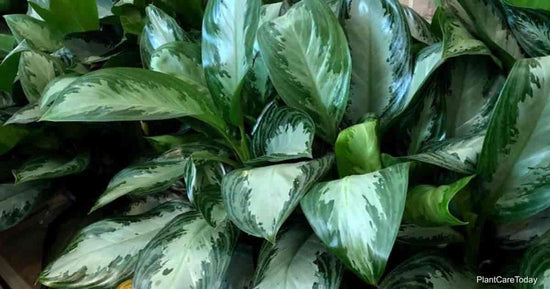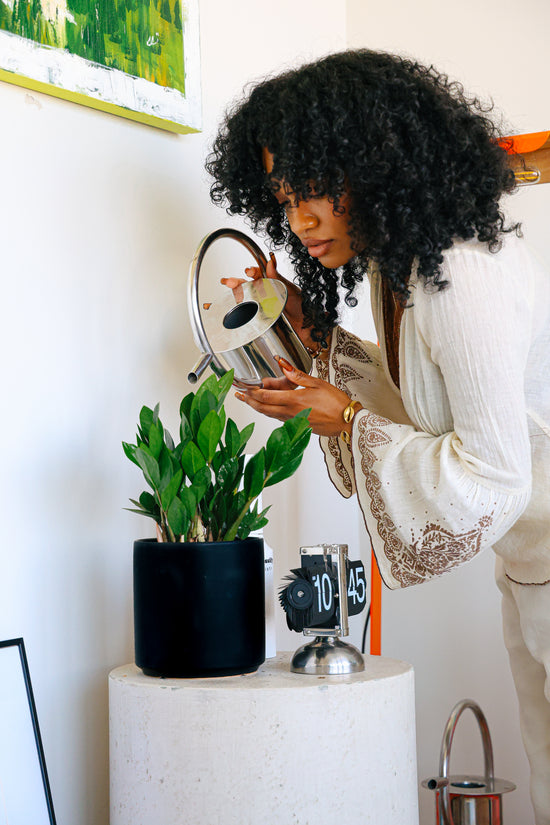Maintenance: Intermediate | Climate: Warm + Humid | Light: Bright + Indirect | Watering: Semi-frequent | Pet Safe: No
CHARACTERISTICS
The Prince of Orange is highly sought after for its beautiful color changing palette. New growth comes in bright orange and gradually shifts into terracotta before developing its mature green coloring. This variety can grow about 3 feet tall and wide.
LIGHT
Offer your Prince of Orange bright, indirect light to maintain its appearance and growth. Sunlight filtered through blinds or curtains, and placement a few feet away from a bright window is ideal. It will tolerate lighting in between bright and low, however, it will affect its size and color. Keep it away from direct sunlight and rotate it regularly for even growth.
WATER
Water generously once the top 50%-75% of soil has dried, allowing excess water to drain out. It can tolerate brief periods of drought on occasion but keep in mind that this plant is native to tropical environments. Reduce watering frequency during fall and winter. To maintain the quality of your soil and leaf appearance, we do not recommend tap water.
AIR
Mimic a tropical environment in your space to keep your Philodendron happy. Maintain temperatures between 65º-85º and create extra humidity in the room. Provide a boost of humidity by:
- Misting the leaves 3-4x per week with non-tap water
- Adding a humidifier nearby
- Making a pebble tray that lives underneath the pot
- Placement in a bathroom or kitchen, if lighting is suitable
Keep your plant away from drafts, air vents, and heat sources. Extreme temperature fluctuations will cause your plant distress.
PLACEMENT
Philodendrons symbolize health and abundance, offering a deeper and intentional connection to its care. Thoughtful placement in your home can channel positive energy for health and positivity. While keeping the environmental needs in mind, consider placing it at the center of your room, where you gather with family, or in a bedroom, so you can keep its symbolism in mind daily.
POTTING & SOIL
We recommend a ceramic planter with plenty of drainage to provide an ideal moisture balance for your Philodendron. When repotting, keep it in a planter of the same size or no more than 2 inches larger. To grow your plant larger, pot up in size annually for the first 1-2 years. Read through Pruning and Propagating below to keep your plant at a manageable size.
A well-draining soil with amendments such as coco coir, perlite, and bark will provide a healthy balance of moisture retention, aeration, and drainage. This is important to ensure its roots have space to spread and are not suffocated by waterlogged soil.
SEASONAL CARE
When you’ve gotten the hang of it, Philodendron care is pretty simple year-round. Like all plants, there are a handful of seasonal notes to remember:
- Maintain comfortable temperatures and moderate humidity levels through fall and winter
- Move your plant a few feet away from cold or drafty windows
- If possible, bring it to a brighter area to make up for shorter daylight
- Water less frequently during cold months, after the soil has dried about 75%
- Avoid repotting, fertilizing, and other drastic changes that stress the plant
PRUNING & PROPAGATION
Pruning is key for maintaining a healthy and robust plant. Removing damaged and old leaves allows the plant to direct all its energy to healthy growth. With strategic pruning, you can also propagate the Prince of Orange to grow mini new plants.
To propagate your plant, you’ll need:
- Clean + sharp pruning shears or scissors
- Jar or glass of room temperature, non-tap water
- Healthy, mature Prince of Orange plant
- Cinnamon (optional)
How to propagate:
- Choose healthy stem(s) with a node or aerial root at the end. Make your cut above the node on a stem with multiple healthy leaves. Aerial roots are brown roots that grow above the soil.
- Allow your cutting to sit out for 24-48 hours so the cut can callous before placing it in water. You can also sprinkle cinnamon on the exposed cut(s) to prevent infection.
- Fill your clean glass with non-tap, room-temperature water.
- Place your stem cutting(s) inside the jar and put it in a bright, indirect spot.
- Refresh with clean water + pot into soil when roots are at least 3 inches long.
Be aware that the longer your propagations sit in water, the harder it will be for them to transition to soil when they're potted. Never prune plants more than 10-20% at a time.
COMMON ISSUES
You may see few issues when caring for this intermediate-level plant but when changes are spotted, you'll want to address it quickly. Some common issues your Philodendron Prince of Orange might experience are:
YELLOW LEAVES
Leaf discoloration is often due to overwatering, low light, age, or a nutrient deficiency. To identify the cause of your yellowing or discolored leaves, check the soil moisture to confirm if it's moist or dry. Soil should be watered after it has dried about 50% down and bright, indirect light is best. The oldest leaves will also yellow off as the plant makes room for new growth.
BROWN LEAVES, TIPS, OR EDGES
Dry, crispy leaves or edges are a sign of underwatering, low humidity, leaf scorch from direct sunlight, or fertilizer burn. Start by assessing the soil moisture, lighting, and how much humidity you’ve provided. If you recently used a fertilizer treatment, the concentration may have been too strong. Prune away damaged leaves if needed.
CURLING LEAVES
Philodendron leaves curl when the soil or air is very dry. It can also happen as a result of temperature stress and pest infestations. Check the soil moisture and give it a generous drink, if needed. Be sure to mist regularly, create a pebble tray, or add a humidifier nearby to give it a tropical, humid environment.
DROOPING, LIMP LEAVES
Drooping leaves are common when your plant is under or overwatered, while adjusting to an environmental change, pest and fungus infestation, or when your plant needs a bigger pot. Check the soil moisture and read above to assess its environment.
NO ORANGE LEAVES
New growth on the Prince of Orange should show bright orange in the beginning stages of the leaf. Eventually, this deepens into a terracotta-copper shade before becoming green. There may be multiple times of the year when your plant is fully green. Make sure it's in bright, indirect light to produce more growth!
SMALL GROWTH
Philodendron's will see stunted growth under low lighting, poor nutrition, and inconsistent watering. Do your best to follow the care needs above so you can witness plenty of growth!
PRO TIPS
- Prune away the oldest leaves (closest to the base of the plant) to encourage full, healthy growth.
You're a pro now! If any of your questions haven't been answered, let us know!





